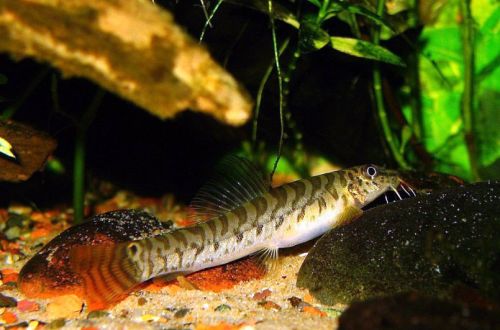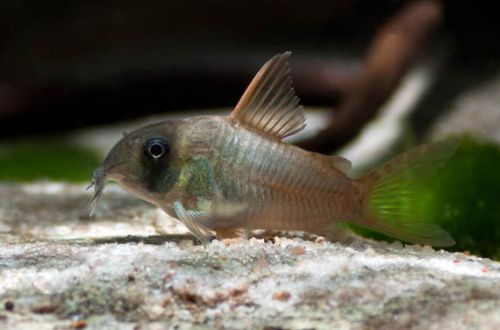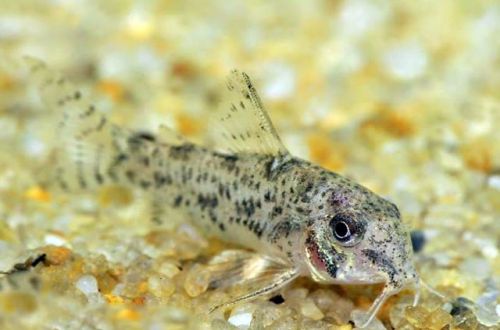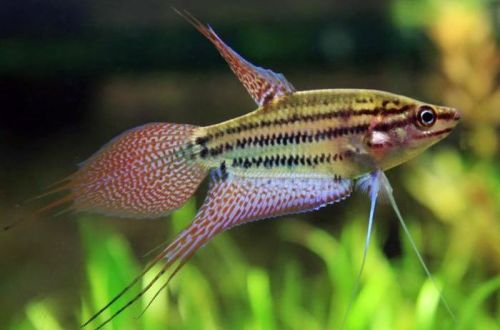
Spotted Char
Acanthocobitis botia or Spotted Char, scientific name Acanthocobitis botia, belongs to the Nemacheilidae family. A calm, accommodating look, can keep company with many tropical fish. Easy to maintain and does not require large financial investments, it can be added to an existing freshwater aquarium.

Contents
Habitat
It was previously thought that the natural range of this species covers a vast territory from Pakistan to Thailand. However, more recent studies (from 2015) have established that the Spotted Charr is found mainly in the Brahmaputra River basin, and its close relatives live in other parts.
The habitat is variable due to alternating rainy and dry periods. Thus, the fish is successfully adapted to life in various conditions – stormy muddy waters and calm currents of translucent rivers. Prefers regions with sandy or rocky substrates and natural “garbage” (leaves, branches, snags).
Brief information:
- The volume of the aquarium – from 70 liters.
- Temperature – 21-26°C
- Value pH — 6.0–7.5
- Water hardness – soft (2-12 dGH)
- Substrate type – sandy or fine gravel
- Lighting – subdued
- Brackish water – no
- Water movement is weak
- The size of the fish is 8–10 cm.
- Nutrition – any drowning
- Temperament – peaceful
- Content in a group of at least 5–6 individuals
Description
Adult individuals reach a length of about 8–10 cm, sometimes they can grow up to 15 cm. Sexual dimorphism is weakly expressed. It is possible to distinguish a male from a female by size, the latter will be much larger. The coloration is gray-yellow with a brown pattern, the abdomen is silvery. The tail and fins are reddish in color. Young fish are lighter and differ in body pattern. Sensitive antennae are located on the head near the mouth, helping to search for food at the bottom.
Food
In the wild, they feed on small crustaceans and aquatic insects, their larvae. In the home aquarium, it is acceptable to serve dry sinking food as the basis of food. However, several times a week it is necessary to dilute the diet with live or frozen foods, such as bloodworms, brine shrimp, daphnia.
Maintenance and care, arrangement of the aquarium
The optimal size of the aquarium for a group of 5-6 fish starts from 70-80 liters. The design uses broad-leaved plants, shelters in the form of snags and other decorative elements, a sandy substrate and several large boulders. To create conditions characteristic of the natural environment, you can place a few leaves of Indian almonds on the bottom, which will turn the water brown. It is recommended to set a subdued lighting level and ensure a low flow of water.
The maintenance of the Spotted Charr does not differ from the maintenance of other aquarium fish. Requires weekly replacement of part of the water with fresh water, regular removal of organic waste and periodic renewal of the leaves, if used.
Behavior and Compatibility
Peaceful friendly appearance, goes well with other calm fish of comparable size. It coexists most harmoniously with schooling cyprinids, many of which come from the same habitat. It is necessary to keep at least 5-6 individuals in a group. Alone, he will become overly shy, which will negatively affect his well-being, and may begin to refuse food.
Breeding / breeding
There is not enough information about breeding in home aquaria. At the time of writing, juvenile Spotted Charr are caught from the wild for sale. There is no mass breeding on a commercial basis.
Fish diseases
By their nature, non-ornamental fish species that are close to their wild relatives are quite hardy, have high immunity and resistance to various diseases. Health problems can be the result of inappropriate conditions, so before starting treatment, check the quality and parameters of the water. If necessary, bring all values back to normal and only then begin treatment, if necessary. Read more about diseases, their symptoms and methods of treatment in the section “Diseases of aquarium fish”.





